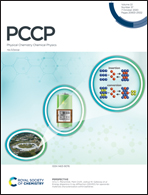Magnetic studies of polylactic-co-glicolic acid nanocapsules loaded with selol and γ-Fe2O3 nanoparticles
Abstract
The as-prepared (MSE-NCs sample) and lyophilized (LMSE-NCs sample) polylactic-co-glicolic acid (PLGA) nanocapsules loaded with maghemite (γ-Fe2O3) nanoparticles and selol (Se-based anticancer drug) were investigated by means of dc magnetization, ac susceptibility and electron spin resonance (ESR) measurements over the temperature range of 4–300 K. The magnetic data of the as-synthesized nanocapsules containing only maghemite nanoparticles (M-NCs sample) or selol (SE-NCs sample) were also collected for comparison. The magnetic nanocapsules reveal perfect superparamagnetic (SPM) behavior only around room temperature; at temperatures lower than 200 K the SPM scaling is not observed and all samples behave as interacting superparamagnetic (ISPM) materials. The evolution from the ISPM to the SPM regime is marked by a steady decrease in the hysteretic properties of all samples, with the temperature dependence of the coercivity decreasing slower than the T1/2 behavior predicted for non-interacting SPM particles. The SPM character of the samples is also confirmed by the occurrence of a maximum in the temperature dependence of both real χ′(T) and imaginary χ′′(T) components of the ac magnetic susceptibility, which shifts towards higher temperatures with increasing frequency. Moreover, upon decreasing the temperature the ESR signal shifts to lower fields and gradually broadens, following closely the predictions for the ESR of SPM particles. Additionally, an unusual giant diamagnetic response is observed at low temperatures. The ZFC magnetization is found to reverse its direction and becomes diamagnetic, whereas the FC branch remains positive. Even when compared with usual superconductors, the order of the diamagnetic susceptibility for the lyophilized sample (−10−2 emu g−1 Oe−1) is quite considerable. The nanocapsules herein reported and the presented analysis of their magnetic properties we envisage can support the engineering of magnetic nanocapsules for applications in magnetic drug delivery systems and as magnetic hyperthermia inductors in antitumor therapy.

- This article is part of the themed collection: 2020 PCCP HOT Articles


 Please wait while we load your content...
Please wait while we load your content...